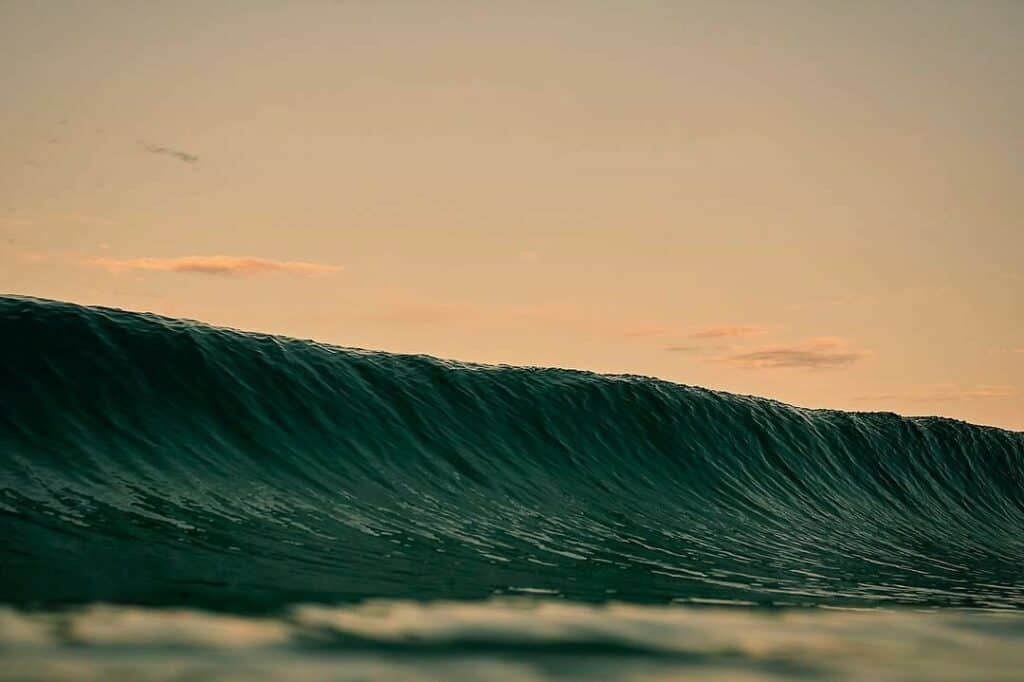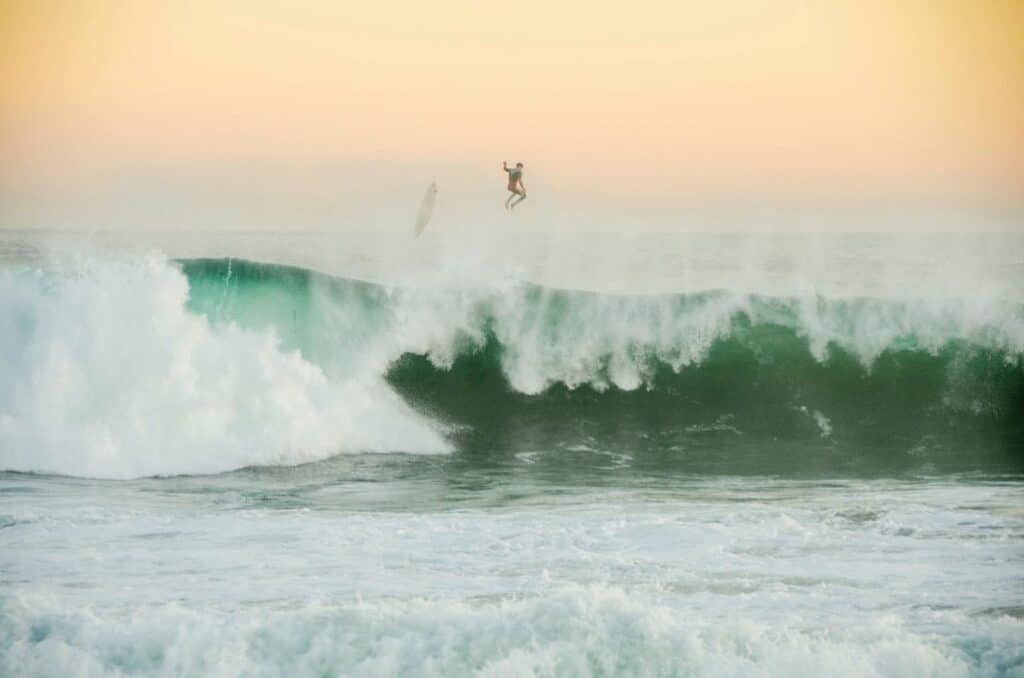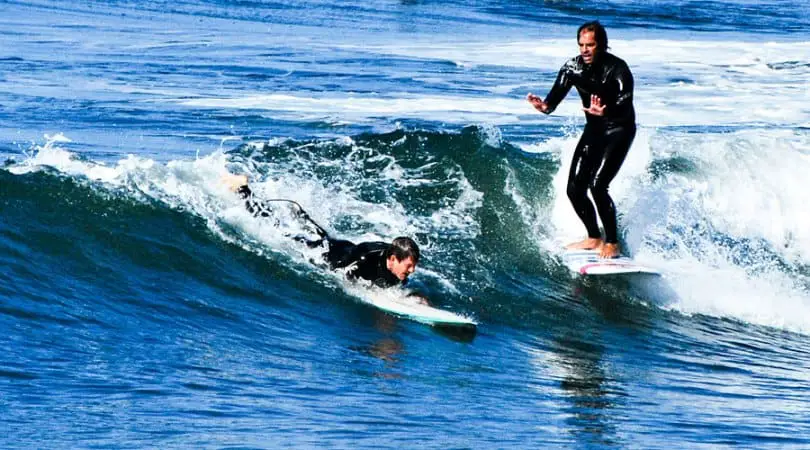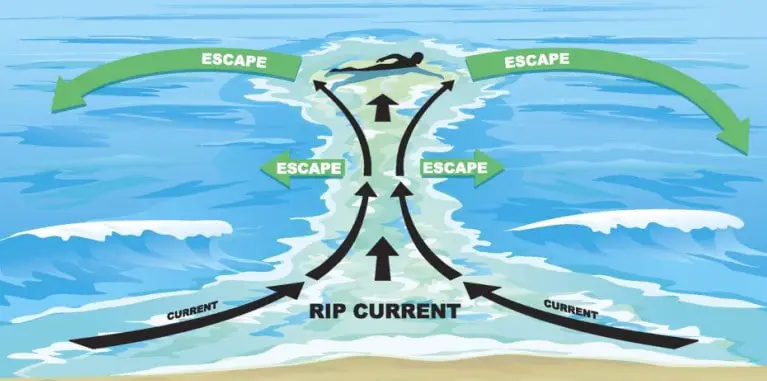
The Ocean can never be underestimated and even the most experienced of surfers can be intimidated by its power.
For that reason, surfing safety is a fundamental matter for beginner surfers to grasp to ensure they are doing the simple things right and not putting themselves in unnecessary danger.
Surfing is a physically demanding sport that is unlike most others. It takes place in an unpredictable and dynamic environment in which nature is in full control. However, with the right knowledge of how to mitigate the risks, you can feel comfortable that you are surfing safely.
In this surfing safety guide we’ve put together what we feel are the main areas of which you must educate yourself (with a couple of no brainers thrown in for good measure!) when you start on the journey as a beginner surfer.
Read next – How Dangerous is Surfing
1. Comfort Zone/ know your limits
With surfing it is particularly important to know your limits. Often times you’ll have a quick glance at the waves from the beach and think it looks pretty calm and small, then when you are actually out there, the waves are much heavier than you thought!
We often think that large waves are risky but you will find that even smaller waves can pack a real punch, particularly if they are dumpy or breaking in shallow water. Never underestimate the ocean’s power!
To some degree, pushing your personal limits is the only way to improve your surfing (and anything else in life for that matter…) but as an inexperienced surfer – trying to surf in conditions which you do not have the skills to match is dangerous not only for yourself but for others in the water too.
Take it one step at a time as you graduate to more difficult waves, and have the sense to know when the waves are too challenging for you.
2. Fitness
Surfing requires a high degree of general fitness. In order to ensure you are surfing safely, at anytime you should be able to swim without your board and in ocean conditions.
While I’ve referred to “general fitness” above I realise this isn’t totally accurate, surfing requires a very unique and specific degree of fitness due to the large range of physical movements that are involved. Upper body strength and paddling ability ranks as probably the most demanding set of movements that you must be able to undertake comfortably.
One of the best ways to train your body for paddling is to swim in a lap pool. It will help with your paddling and also assist in the event you need to swim back to the beach without your board.
3. Swimming Ability
As we mentioned before, there’s always the potential for you to become separated from your surfboard (leash breaking etc) and therefore it can’t be relied upon as a safety device. Many inexperienced surfers rely a little too much on their surfboard for their personal safety in the surf.
But as much as general swimming will help in improving your fitness, swimming in the ocean is very different to swimming in a pool. There’s no luxury of a side to grab onto or a shallow section to stand, as well as contending with waves and currents to contend with.
That said, it’s a very good idea to improve your general skills or even take surfing lessons if you need to. Try swimming in the ocean too to get used to what it is like and then if you ever find yourself needing to swim without your board in a tight situation you won’t panic.
Improving your swimming skills is key to surfing safely and will make you more confident in the water and enhance your experience.
4. Check the surf, tides and weather forecast
As surfers we are constantly having to monitor the forecast as good waves come and go, and weather systems can change rapidly. On the surf front, swell can also build pretty quickly and catch an inexperienced surfer off guard.
I’ll never forget one time when I was on a road trip passing by an infamous surf spot. From the car park the surf looked manageable. I knew that there was a predicted jump in swell and it actually hit within the half hour I was surfing there. Before I knew it the waves doubled in size and I was out of my depth. To make things worse, it was not the easiest spot to just paddle into the beach as it was surrounded by sheer rock faces.
The point is that conditions can change very quickly without you realising, so it’s best that you have an idea of the conditions before you go and further, that you start to work out how surf forecasting works.
5. Hold on to your board
When paddling out into the oncoming waves it is important to hold on to your board even in a situation where you do not think you will make it through a wave.
On a shorter board you will usually try to duck dive under an oncoming broken/ breaking wave.
On a longer board you will need to do a turtle roll (roll onto your back and bring the board through wave held above you).
If this isn’t possible and you have no chance of making it you can’t let the board go as it will extend the length of the leash and serve as a serious weapon that can easily hit someone behind you and cause major injury or worse.
In this situation hold the board to your side securely and try to pull the board through the wave with you. Do not keep the board between you and the breaking wave as it will likely hit you directly in the face. This is a very common mistake made by learners.
Also, don’t ever paddle out directly behind someone as they could easily collide with you if they don’t get through a wave.
6. Wiping out the “right way”
All surfers wipe out and eventually you will learn the best way to do so. As a beginner surfer you will be falling off your board a lot so it is best to try and do it in the safest way possible.
Protect Your Head When You Fall – your first movement should be to cover your head with your arms to protect it from your flying surfboard, the ocean floors and other people. You will need to take extra care in shallow water and try and avoid landing head first.
Try to fall away from your surfboard and do your best to land in the water flat on your back with your arms out to stop yourself from hitting the bottom. This is more of a concern in shallow water.

7. Patrolled Beaches
If you are surfing near a patrolled swimming area (and you don’t want to get yelled at over loud speaker by the lifeguards) you’ll need to ensure you are not drifting into the off limits area to avoid potential collisions with swimmers.
8. The Priority Rule
One of the golden rules at any given surf spot is that the surfer closest to the breaking wave (a.k.a on the inside) has first priority to take that wave. If you see someone on the inside of you who is already on the wave, then that wave is taken and you cannot drop in.
If you want a quick way to earn some nasty enemies, try ignoring this rule!

9. Surf Etiquette (Respect for other surfers)
Surfing is a popular sport and it seems like it is only getting more crowded in the water each day.
Therefore, it’s a given that there will be accidents, collisions and angry people to contend with if you are in the wrong (or if someone else thinks you are in the wrong.
You can avoid many situations with other surfers by using common sense and consideration of the following:
- Respect the locals: Locals notoriously are very protective of their surf break and more importantly their “right” to surf there. If you go in gung ho and try to catch every wave, get in their way or drop in on waves that are already taken you will be on a surefire path to making some people really angry. Wait your turn, be respectful and most times the locals will show you respect back.
- Avoid really crowded surf breaks (especially as a learner): At a super crowded spot, you’ll be lucky to catch any waves anyway, so best to surf either away from the main peak or find another break nearby.
- Get an understanding of key surfing rules & etiquette (eg priority rule as mentioned, respect to locals).
- Hold on to your board (as mentioned earlier) to avoid it hitting other surfers.
10. Practice (& Quantity over Quality)
Like anything, if you want to improve your surfing you will need to put in the time and surf as much as possible. You’ll quickly gain confidence and have more fun, and if you effectively follow these guidelines for surfing safety, you won’t have any problems.
Also remember, that as you are learning to surf it’s more important to surf as many waves as possible, than surfing the perfect wave. It’s all about quantity over quality.
11. Food and alcohol
This is a pretty common sense one – it’s not a great idea to go surfing soon after eating and a definite no if you’ve been drinking alcohol!
12. Rips (Learn how they work)
Getting caught in a rip is something that make most learner surfers or swimmers who lack confidence panic. It is however, important to realise that rips are very common and you need to act calmly and you will be ok.
A rip current will take you away from the beach and pretty quickly too. The knee jerk reaction of a lot of people is to swim/paddle directly against the current to try and swim back to the beach which is futile. You’ll get tired, you’ll panic and that’s when things can go wrong.
You need to paddle at a perpendicular angle away from the rip and you’ll quickly get out of the rip itself. At this point you might be quite a bit further from the beach itself however, you won’t need to fight against a current anymore to paddle back to the beach.

13. Getting in and out of the water
It’s always worth assessing how you will get back to the beach when you are entering the ocean. This is probably simple at most beaches but some surf spots can be a bit trickier with the presence of cliff faces, rocks, reefs, and unique currents or tidal movements.
For beginner surfers, we wouldn’t recommend you surf at a break where it is difficult to get out of the water.
Some breaks require entry to the water via rocky points where surfers jump from the rocks into the surf lineup by timing their jumps in between sets. This kind of entry is definitely not suited to beginners and can be really dangerous.
If you’re unsure, ask someone. If it feels like you’re biting off more than you can chew as a beginner surfer, then you should probably look for an easier spot to surf at.
14. Under water landscape hazards
It may not be the first thing you think of when thinking about surfing safety, but the natural hazards that you can’t usually see so well such as rocks, reefs or boulders pose one of the more significant risks to surfers.
Some of these natural features only become a hazard at certain tides, and if you don’t have a good knowledge of the location you may find out the hard way.
Particularly when you are surfing for the first time in an area, take it easy while you get to know the lay of the (underwater) land.
Man made obstacles (eg. jetties, piers)
It may seem obvious but leave surfing near or through these sorts of spots to the experienced surfers.
Reefs
Like we mentioned above, if you’re surfing at a break for the first time, it pays to get an understanding of the hazards of that spot. This is particularly the case for waves that break over reefs, where an understand of the tides etc are vital.
Beginner surfers probably won’t be surfing at shallow reef breaks, and you can certainly find reef breaks that are more mellow and never get so shallow to be considered particularly dangers. Wear booties and you will be ok. The main point here is to try and get an understanding of where you are surfing.
15. Sunblock & hydration
Another fairly obvious one but make sure you have sufficient sun protection – either sunscreen, a rashie or wetsuit and stay hydrated.
16. Surf with others
It’s always a good idea to surf with at least a few other people in the water in case something goes wrong. If you’ve a buddy who can surf, even better – as it helps to have someone more advanced to learn from and emulate the things they do.
17. Warm up and check out the conditions
A quick warm up and stretch before getting into the water is a good way of reducing risk of muscle injuries or cramping. It’s also a good opportunity for you to review the surf conditions and any hazards.
18. Get the the right surfboard
Ride a surfboard that’s suited to your level of experience. As a learner, it’s important to get the right size surfboard that will allow you to progress fastest but also that you will be able to control. Check out our best surfboards for beginners guide here.
19. Wear a Surfboard Leash
For most surfers wearing a leash with a surfboard is a definitie given, however it is a big topic at the moment for traditional longboarders as many think a leash takes away from the experience. There are implications of not wearing a leash, with people having loose boards hit them etc. So… wear a leash!
20. Ocean Animals
Sharks
Sharks are the single biggest fear that most people have about venturing into the ocean, however, the fear-mongering has been overhyped and sensationalized over the years.
They say the chance of getting attacked by a shark is less than getting struck by lightning or a car accident, but it does of course happen and when it does – it’s global news it seems.
Shark attacks tend to occur in particular locations so this comes back to the idea of getting to know the location you are surfing, as a frequent presence of sharks will be well known. If a surf spot is known as a “sharky” spot you may rethink your plans to surf there.
Read next – What to do if a shark approaches you while surfing
Other things to note:
- Avoid surfing at dusk or dawn (this is difficult sometimes, when the waves are good!
- Don’t surf alone
- Avoid surfing at river mouths, particularly following rain, as the runoff into the ocean can attract particular types of sharks
Overall, the chances of seeing a shark (let alone being attacked by one) is extremely low so if it is something you are worried about, forget the hype and use some common sense – you will be ok! Many people take comfort using things like Sharkbanz (check out our review here) – maybe they could help give you some more confidence.
Stingers & Jellyfish
The sorts of jellyfish that you may see vary a lot from place to place but for the most part if you get stung, just head straight to the beach and if possible see a lifeguard. The most common treatment is the application of vinegar for general stings.
In my local surf spots when the wind blows on shore for a day or two, we are guaranteed to get stingers rolling in.
It will be common knowledge if there are known to be anything more serious in the water of your local break so again, it helps to talk to other people or surfers to gain some inside knowledge.
We hope that you’ve learned something from our surfing safety guide and that you’re pumped to get out in the waves.
Check out out some of our recent posts:
Build your own DIY Surf Rack.! Please reach out in the comments if you have any questions for us.
Don’t forget if you are looking for more tips for beginner surfers – check out our other posts here.
